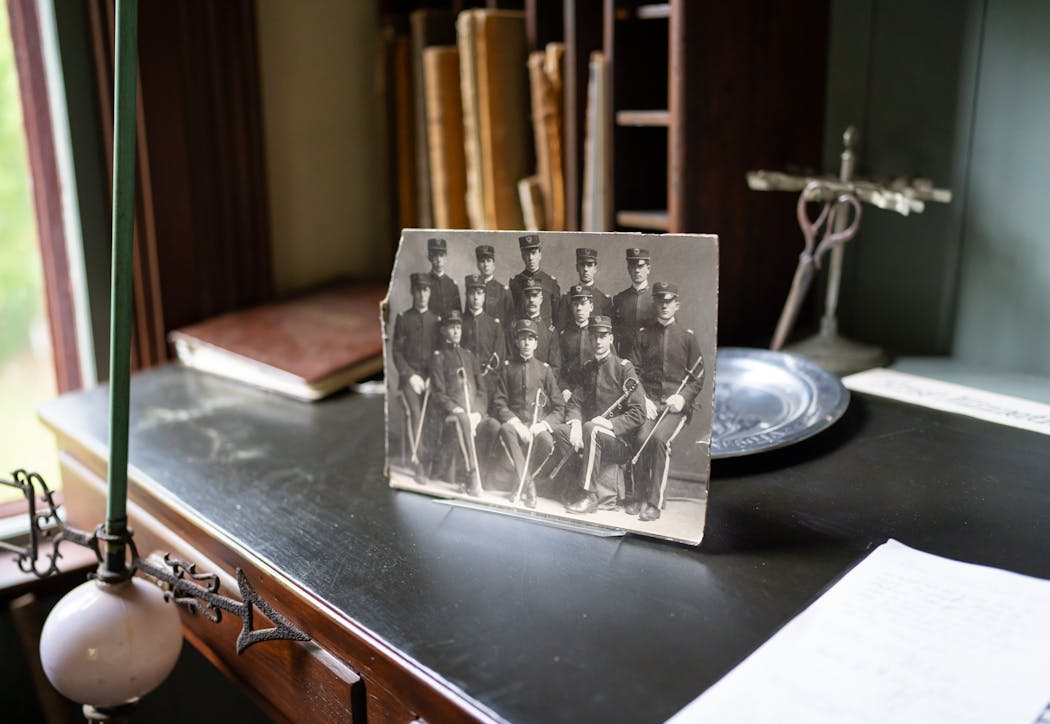On a hill in Minnetonka overlooking a winding creek, a Victorian estate hasn't changed much in more than a century — and that's the point.
The Charles H. Burwell House has been preserved and rehabbed to showcase its unique history and is a link to the state's once-prominent milling industry.
The Italianate house was built for the manager of the Minnetonka Mills Co. — the first Minnesota mill west of Minneapolis and likely the biggest employer in the Minnetonka area at the time, preceding the peak of milling in Minneapolis.
"It was pretty significant ... in the early days of flour milling," says Jan Cook, president of the City of Minnetonka Historical Society.
The mill was torn down more than a century ago, but the "gothic-stick-style" house built nearby in 1883 for the Burwell family gives visitors an interactive history lesson of the Victorian era and the booming business that once thrived there.
"It's really quite a gem," Cook says. "We don't have a lot of buildings ... in Minnesota that are historic. It's just a reminder to people of how people lived back then."
The Burwell House, which is listed on the National Register of Historic Places, draws an average of 1,500 visitors a year for the free tours and special events hosted by the city and historical society. Tours will be held on Sundays this monthand during a special holiday event Dec. 3 featuring Victorian Christmas decorations.
'The perfect place'
Crews first constructed a lumber mill next to a 12-foot waterfall on Minnehaha Creek, which was much wider at the time, navigable by a steamer boat to Lake Minnetonka. The creek, which flows into the Mississippi River, and the surrounding land had been inhabited for thousands of years by Indigenous tribes before white settlers moved in.
After the lumber mill burned down, it was replaced by a flour mill, producing 300 barrels of flour a day that was shipped to the East Coast and Europe — Minnesota's largest flour mill west of the Mississippi at its peak, Cook says.
"It was the perfect place to harness the water power," she adds.
Charles Loring, considered the father of Minneapolis' parks system, and his friend Loren Fletcher owned the Minnetonka Mills Co. and hired Burwell to manage it, Cook says. As the business grew, Burwell decided to build a house nearby for his wife, Mary, and their family, complete with a tall tower and ornate furnishings.
"If people came down the creek to do business in Minnetonka Mills, they'd see this house and it was pretty impressive," Cook says.
The woodwork and doors are pine but painted to look like oak. Other parts of the house, including floral wallpaper, were reproduced to look like the original décor thanks to the preservation of Burwell's detailed house plans.
"Victorians are two things: cheap and they want to impress you," says volunteer tour guide Petey Ellis, a retired teacher, as she points out the slate fireplace mantel made to look like marble.
Over the decade she's been giving tours, visitors have come from all over Minnesota and the globe, she says. While there are more impressive historic mansions in Minnesota, the Burwell House is a relic of a more modest, middle class Victorian family.
"It really portrays beautifully how people lived," Ellis says. "It encompasses part of our history that could easily be lost."
Restoring history
After the mill was torn down in 1900, Burwell became a postmaster. His family lived in the house until 1958 before selling it to another family. The city of Minnetonka bought the house in 1970 and it was added to the National Register of Historic Places.
The house has been restored to how it looked in 1894 when an expansive front porch, second kitchen and other buildings were added. It costs the city about $17,500 a year to maintain the historic house, excluding labor and capital project costs, according to the city.
The Burwell name also carries significance in the forming of the west metro suburb. Some Minnetonka residents could be living in the city of Burwell today if a 1956 name change had gone a different way.
That year, residents were becoming concerned that too much of Minnetonka, then a township, was being annexed by surrounding cities, so they sought to form a village. Some proposed two separate villages called Minnetonka and Burwell while another faction preferred just one: Minnetonka. Voters picked the latter.
But the name lives on in the yellow house on the tree-lined hilltop, taking visitors of all ages back in time to another era.
Tour the Charles H. Burwell House
Where: 13209 E. McGinty Road, Minnetonka
When: Free tours (no reservation needed) will be held from 1-4 p.m. Nov. 19, Nov. 26 and Dec. 3. Tours are also held on Tuesdays, Saturdays and Sundays from June to August, and Saturdays and Sundays in September. Go to minnetonkamn.gov for more details.

Chants of 'shame on you' greet guests at White House correspondents' dinner shadowed by war in Gaza
Two die in Wyoming, Minn., crash
Oregon's Sports Bra, a pub for women's sports fans, plans national expansion as interest booms
Retrial of Harvey Weinstein unlikely to occur soon, if ever, experts say




